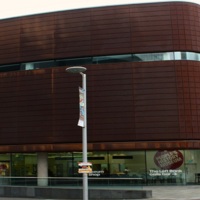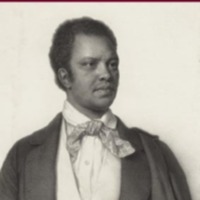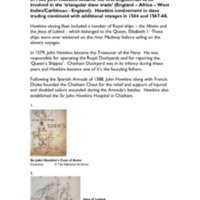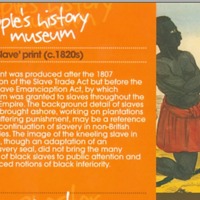
People's History Museum
The People's History Museum (PHM) is Britain’s national museum of democracy, telling the story of its development in Britain; past, present and future. It is located in Manchester, the world's first industrialised city and aims to ‘engage, inspire and inform diverse audiences by showing there have always been ideas worth fighting for’. Attracting over 100,000 visitors a year, with free entry, the museum outlines the political consciousness of the British population beginning with the Peterloo Massacre in 1819. The British transatlantic slave trade and the abolition movement feature in this discussion early on in Main Gallery One. In a small display, the interpretation discusses the role of slave-produced cotton in the rise of Manchester as an industrial powerhouse. It goes on to describe the important role that the people of Manchester had in supporting the abolition campaign. The focus is on the local experience. This is also illustrated with one of the exhibition’s key interpretive characters, William Cuffay, a mixed-race Chartist leader whose father was a former slave. In Main Gallery Two, the displays are brought closer to the present day, other issues explored include anti-racism and attitudes towards migration and multiculturalism. There is a clear link, although not explicitly expressed, in the interpretive text between these ideas and the lasting legacies of Britain's involvement in the slave trade.

Events to mark the bicentenary in the City of Westminster
In 2007 Westminster City Council supported a programme of events in the libraries, galleries and archives of the area, including films, walks and exhibitions, designed to provide opportunities to learn about the culture of Westminster's communities. Highlights included guided heritage walks with historian S. I. Martin, exhibitions of images from the Royal Geographical Society in Paddington Library, Maida Vale Library and Westminster Reference Library, and film screenings (in partnership with 100 Black Men of London). A partnership between the City of Westminster Archives Centre, Tate Britain, Parliamentary Archives, National Gallery and National Portrait Gallery produced a heritage trail 'On the Road to Abolition: Ending the British Slave Trade', which takes in key sites, events and individuals in Westminster relating to the slave trade, between Trafalgar Square and Pimlico. In celebration of Black History Month, Westminster City Council produced a booklet, 'Black History in Westminster', detailing some of the borough's influential Black residents.

Freedom 1807: The Chatham Dockyard Story
The Historic Dockyard Chatham opened a new exhibition in 2007 to look at the history of Chatham in the context of the transatlantic slave trade. The exhibition examined dockyard ‘founder’ John Hawkins - the leader of the first English expedition to transport West African people to the Americas - the work of Chatham-built ships in policing the slave trade post-abolition, and the hidden history of people from ethnic minorities who served in the Royal Navy or worked in the naval dockyard, from the 18th century to the post-Second World War period. The exhibition also looked at Chatham's links to Indian shipbuilding. HMS Gannet (1878), preserved alongside two other historic warships at The Historic Dockyard, is the only surviving British warship to have taken part in the suppression of the slave trade off the coast Africa during the 19th century. Between 1885 and 1888 Gannet undertook anti-slavery patrols in the Red Sea, intercepting Arab slave traders operating off the East Coast of Africa, around the Gulf and the Indian Ocean.

Revealing Histories: Remembering Slavery (People's History Museum)
Events at the People's History Museum in Manchester included a Revealing Histories trail, which highlighted museum objects with links to slavery, such as 'The Slave' print from the 1820s. A living history performance, 'How do you plead?', featured a representation of the Chartist leader William Cuffay, whose campaign for the right to vote saw him transported to Tasmania for treason.